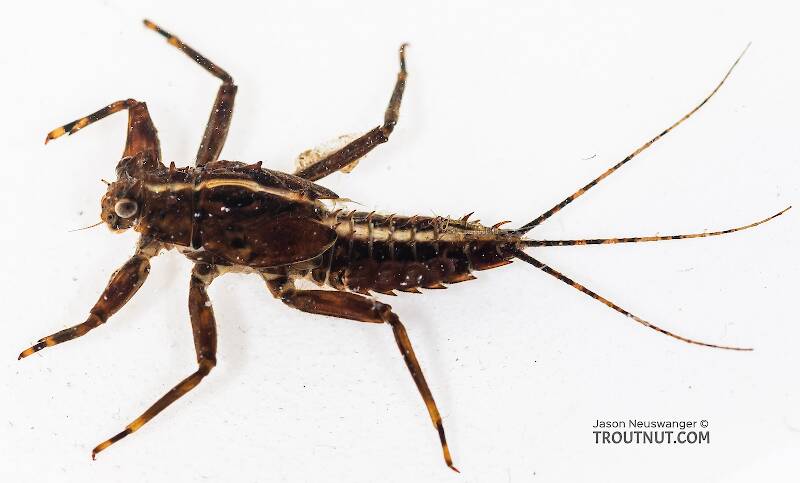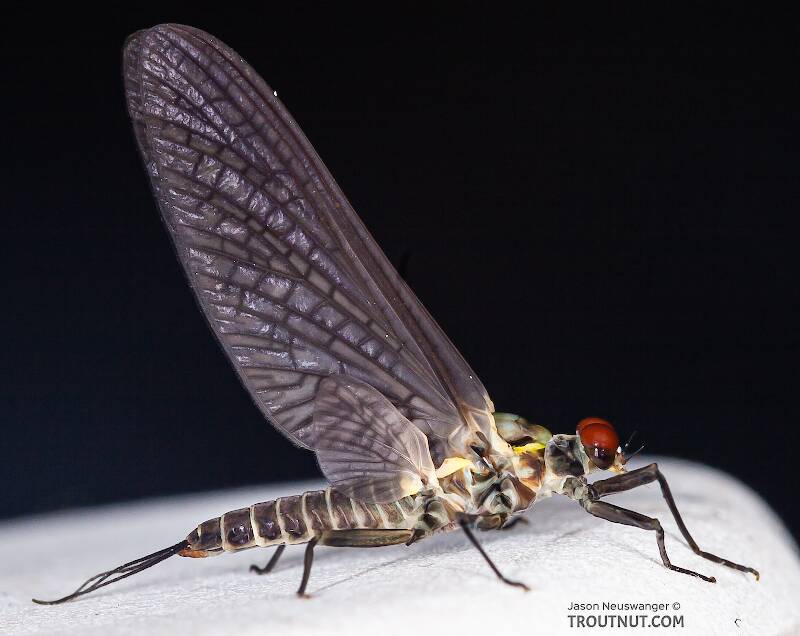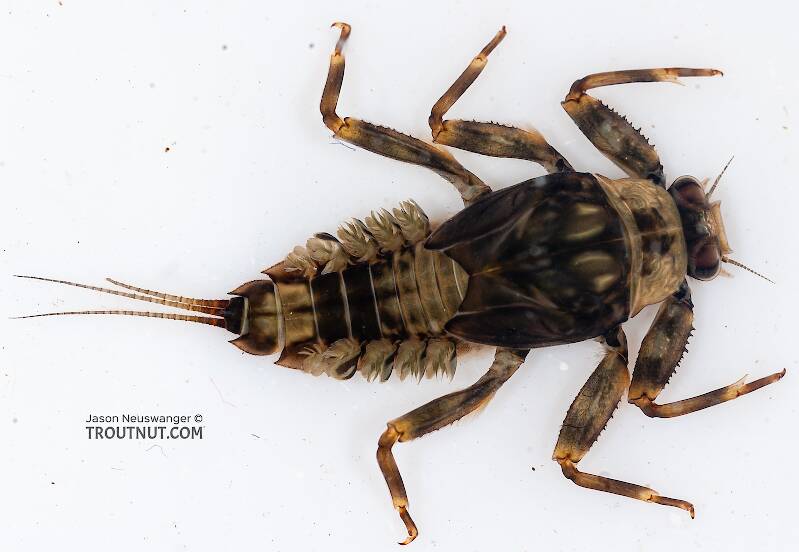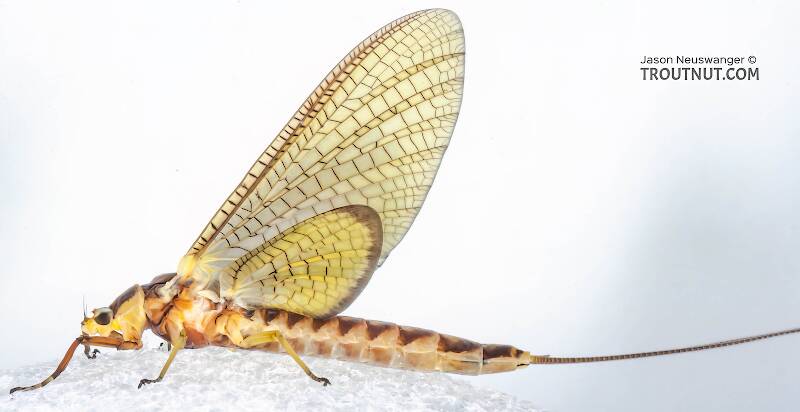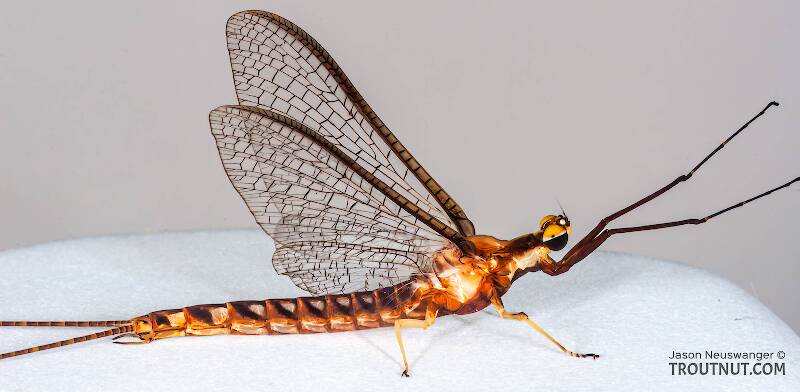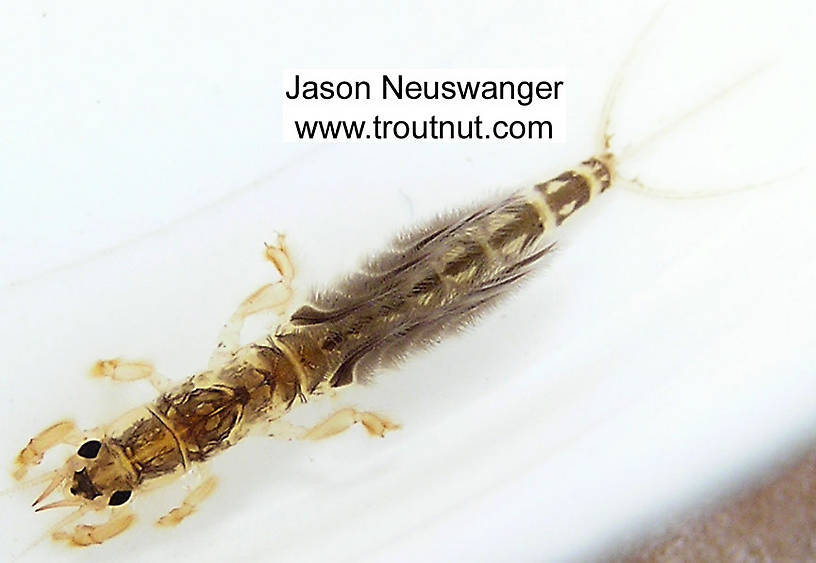
Hex Mayflies
Hexagenia limbata
The famous nocturnal Hex hatch of the Midwest (and a few other lucky locations) stirs to the surface mythically large brown trout that only touch streamers for the rest of the year.
Featured on the forum

This is an interesting one. Following the keys in Merritt R.W., Cummins, K.W., and Berg, M.B. (2019) and Jacobus et al. (2014), it keys clearly to Ephemerella. Jacobus et al provide a key to species, but some of the characteristics are tricky to interpret without illustrations. If I didn't make any mistakes, this one keys to Ephemerella mucronata, which has not previously been reported any closer to here than Montana and Alberta. The main character seems to fit well: "Abdominal terga with prominent, paired, subparallel, spiculate ridges." Several illustrations or descriptions of this holarctic species from the US and Europe seem to match, including the body length, tarsal claws and denticles, labial palp, and gill shapes. These sources include including Richard Allen's original description of this species in North America under the now-defunct name E. moffatae in Allen RK (1977) and the figures in this description of the species in Italy.

Troutnut is a project started in 2003 by salmonid ecologist Jason "Troutnut" Neuswanger to help anglers and
fly tyers unabashedly embrace the entomological side of the sport. Learn more about Troutnut or
support the project for an enhanced experience here.
Green Drakes
Like most common names,"Green Drake" can refer to more than one taxon. They're previewed below, along with 9 specimens. For more detail click through to the scientific names.
Mayfly Species Ephemera guttulata
These are pretty much always called Green Drakes.
Ephemera guttulata's size, numbers, and hatching characteristics have made it a favorite of fly fishermen since the sport first came to North American waters.
It is on par with the Midwest's Hexagenia limbata hatch for its ability to lure huge piscivorous brown trout to eat insects at the surface once a year. The special charm of the Green Drake hatch is that it often takes place during pleasant spring afternoons. It can be challenging because the large flies are easy for trout to inspect in the daylight and they feed very selectively, especially late in the hatch. The huge difference in appearance between green drake duns and the spinners, white-bodied "coffin flies," makes them a peculiarity among major hatches.
The Green Drakes are on the decline due to environmental degradation.
It is on par with the Midwest's Hexagenia limbata hatch for its ability to lure huge piscivorous brown trout to eat insects at the surface once a year. The special charm of the Green Drake hatch is that it often takes place during pleasant spring afternoons. It can be challenging because the large flies are easy for trout to inspect in the daylight and they feed very selectively, especially late in the hatch. The huge difference in appearance between green drake duns and the spinners, white-bodied "coffin flies," makes them a peculiarity among major hatches.
The Green Drakes are on the decline due to environmental degradation.
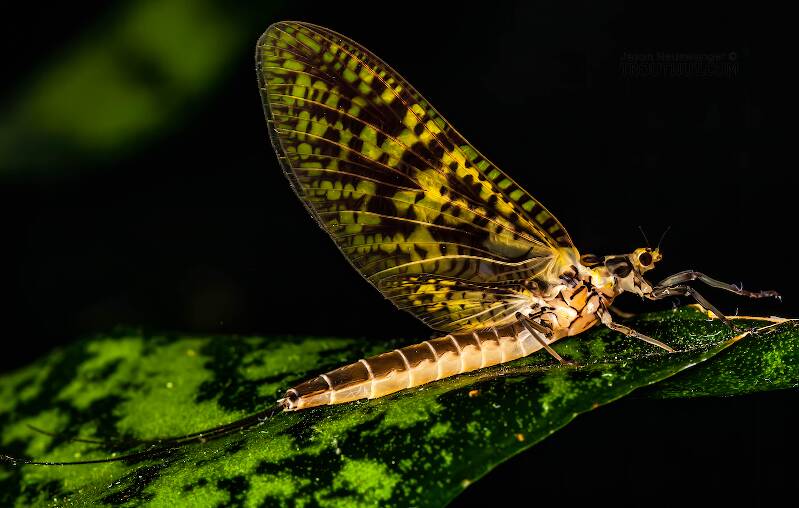
For years after I started this website, I was eagerly hoping to find a green drake to add to the collection, but I was never in the right part of the world at the right time. It finally happened on June 1st, 2007.
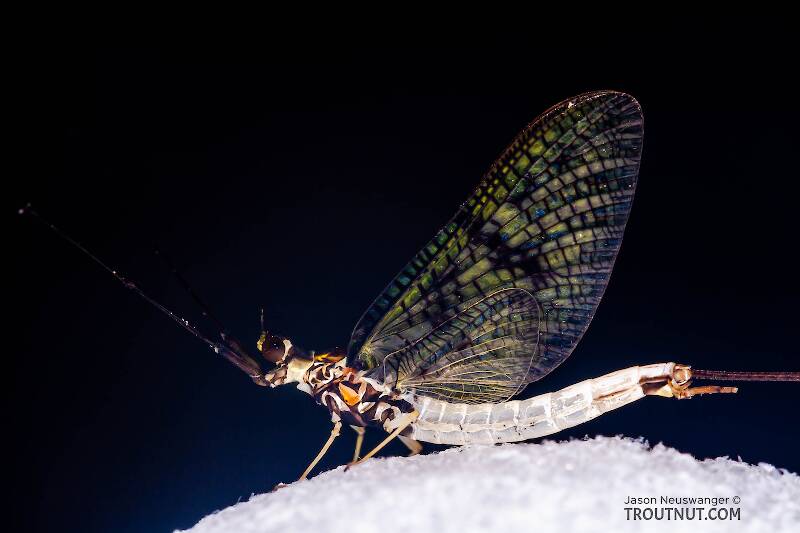
This spinner was the only member of its species I saw all night during an incredibly thick and tricky mixed hatch on Penn's Creek a few days before the real start of its famous green drake hatch.
See 1 more specimen...
Mayfly Species Drunella grandis
These are sometimes called Green Drakes.
This species (or rather group of subspecies), together with Drunella doddsii, make up the famous Western Green Drake hatches. They are widespread throughout the vast Western region and can be abundant enough in many locations to provide world class angling.
It hasn't been all that many years since Western traditions and entomological "facts on the ground" began to influence the angler's lexicon heavily dominated by Eastern writers. Their initial reporting after visiting the region first popularized the phrase "Rocky Mountains answer to the popular Green Drakes of the East". This led to a false impression that lingers to this day. The reality is these giants of their family have abundant populations all over the West with no counterpart in the East, and the West does have abundant hatches of comparable Ephemeridae. The Western tradition of naming outsized Mayflies "Drakes" is the reason for what many consider a misnomer by giving it the same common name as the legendary Ephemerid of the East and surely contributed to confusion for anglers unconcerned with such subtleties.
It hasn't been all that many years since Western traditions and entomological "facts on the ground" began to influence the angler's lexicon heavily dominated by Eastern writers. Their initial reporting after visiting the region first popularized the phrase "Rocky Mountains answer to the popular Green Drakes of the East". This led to a false impression that lingers to this day. The reality is these giants of their family have abundant populations all over the West with no counterpart in the East, and the West does have abundant hatches of comparable Ephemeridae. The Western tradition of naming outsized Mayflies "Drakes" is the reason for what many consider a misnomer by giving it the same common name as the legendary Ephemerid of the East and surely contributed to confusion for anglers unconcerned with such subtleties.
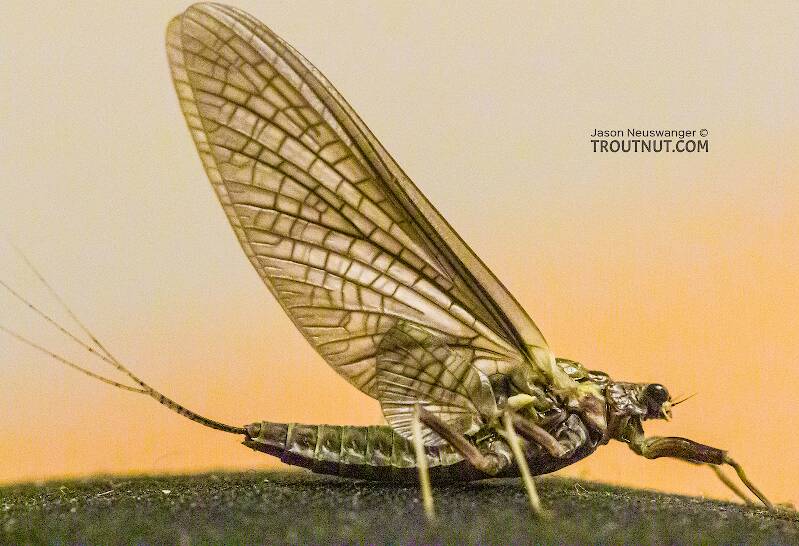
I collected this specimen while away from all my good photography equipment except the camera and one of my macro lenses, so I made do. The lighting is from lamps in a hotel room, so it was hard to edit for really true colors, but I tried to get as close as possible. The body was 13 mm long, wing 19 mm long.
See 10 more specimens...
Mayfly Species Drunella doddsii
These are very rarely called Green Drakes.
This species together with the Drunella grandis sub-species make up the Western Green Drake hatch. Besides being smaller, the adults are difficult to tell apart from it's larger siblings; but D. doddsi nymphs have a few peculiar traits that set them apart. D. doddsi looks much thicker in the thorax, has a flat frontal head margin and a unique oval disk-like ring of hairs on its ventral surface. However, There are very few differences between the habits of these two species, and they are almost always discussed together in fly fishing books, so for many of the characteristics of doddsii, refer to the Drunella grandis page.
See 10 more specimens...
Mayfly Species Hexagenia limbata
These are very rarely called Green Drakes.
It starts like a rise of small trout. There are dimples on the surface--fingerling trout eating midges, perhaps. But these are no fish. The water breaks and out pop the yellow sails of a giant Hexagenia dun. Then another. And another. A vortex appears in a flash below the mayfly and it vanishes with a slurp so loud it echoes off the distant bank. A square tail like a shark fin breaks the surface behind the swirl as a brown trout twice the size of your net retreats back to his deeper lair. The Hex hatch is on.
This Midwestern legend plays out every year on calm, dark, humid nights in early July. Anglers who only fly fish once a year drive hundreds of miles to play their part in the drama, while the mayflies themselves make the television news by showing up on doppler radar or calling snowplows out of dormancy to remove layers of Hexagenia (or "Hex") duns from the bridges. In the cold trout rivers of Wisconsin and Michigan, huge nocturnal brown trout whose usual menu consists of smaller brown trout become, for a week or so, prime dry fly quarry.
According to the literature, these are the second largest mayflies in the United States, behind the related Litobrancha recurvata flies. However, there are reports of limbata exceeding 40mm in some locales, which would make them the largest.
This Midwestern legend plays out every year on calm, dark, humid nights in early July. Anglers who only fly fish once a year drive hundreds of miles to play their part in the drama, while the mayflies themselves make the television news by showing up on doppler radar or calling snowplows out of dormancy to remove layers of Hexagenia (or "Hex") duns from the bridges. In the cold trout rivers of Wisconsin and Michigan, huge nocturnal brown trout whose usual menu consists of smaller brown trout become, for a week or so, prime dry fly quarry.
According to the literature, these are the second largest mayflies in the United States, behind the related Litobrancha recurvata flies. However, there are reports of limbata exceeding 40mm in some locales, which would make them the largest.
See 27 more specimens...
Mayfly Species Hexagenia rigida
These are very rarely called Green Drakes.
This species is reportedly important in places, but it is not discussed very much in angling literature. I suspect its importance is very localized.
References
- Jacobus, L. M., Wiersema, N.A., and Webb, J.M. 2014. Identification of Far Northern and Western North American Mayfly Larvae (Insecta: Ephemeroptera), North of Mexico; Version 2. Joint Aquatic Science meeting, Portland, OR. Unpublished workshop manual. 1-176.
- Merritt R.W., Cummins, K.W., and Berg, M.B. 2019. An Introduction to the Aquatic Insects of North America (Fifth Edition). Kendall/Hunt Publishing Company.


